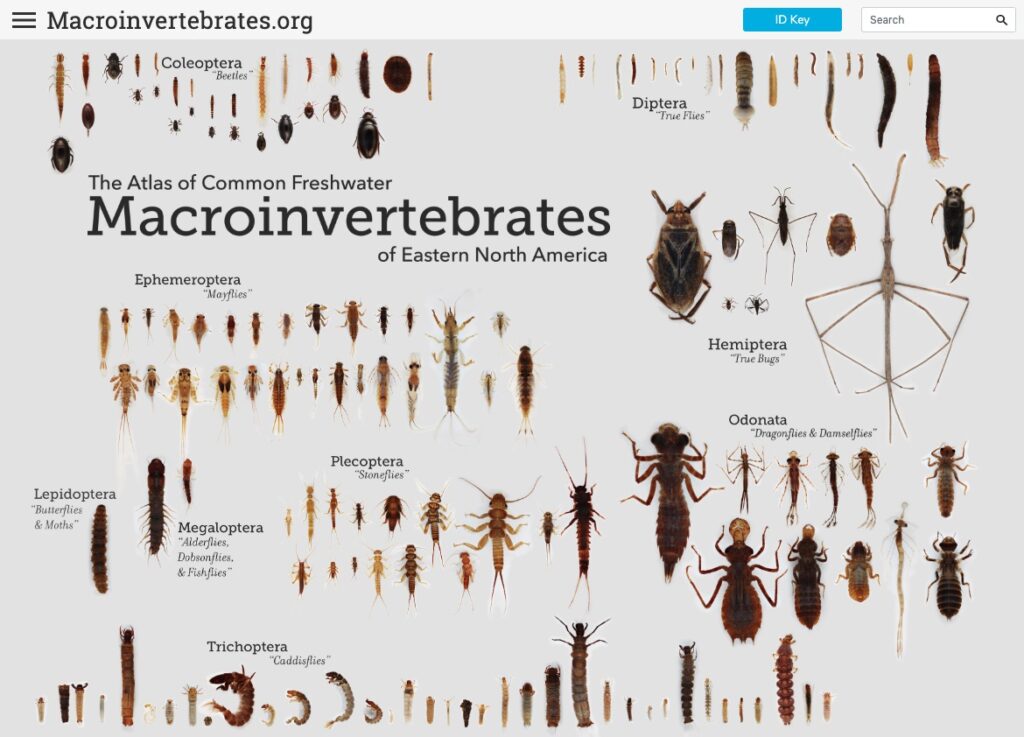How do people make sense of complex visual information in informal and social contexts? How can interaction design facilitate productive learning talk and collaborative exploration? My work explores these questions through learning sciences research at the intersection of data visualization, human-computer interaction, and informal learning.
Below are some of my past projects. For information on more recent work, visit the Technology Integrated Learning Environments (TILEs) Lab website at tiles.cc.gatech.edu.
Projects
Learning to See, Seeing to Learn: A Sociotechnical system supporting taxonomic identification activities in volunteer-based water quality biomonitoring.

Macroinvertebrates.org is a digital teaching collection of commonly found freshwater macroinvertebrates in the eastern United States. Through high-resolution gigapixel imagery and annotations of key diagnostic characters we aim to provide a resource to help water quality biomonitoring organizations train their citizen science volunteers to identify organisms used in water quality assessment. By improving supports for trainers and learners, we hope to improve citizen scientists’ accuracy, confidence, and engagement in macroinvertebrate identification.
Representative Publications:
Roberts, J., Crowley, K., & Louw, M. (2018) Creating a Visual Representation of Expert Strategies to Inform the Design of Digital Tools for Citizen Science. In Proceedings of the 13th International Conference of the Learning Sciences. London, UK. [poster]
Designing Digital Rails to Foster Scientific Curiosity around Museum Collections

In this interdisciplinary collaboration between Northwestern University and the Field Museum of Natural History we investigated how multiple interface design iterations affect visitor engagement with exhibit artifacts.
Representative Publications:
Roberts, J., Banerjee, A., Hong, A., McGee, S., Horn, M., Matcuk, M. (2018) Digital Exhibit Labels in Museums: Promoting Visitor Engagement with Cultural Artifacts. Accepted into Proceedings of ACM SIGCHI Conference on Human Factors in Computing Systems (CHI ’18). ACM. Best Paper Honorable Mention
Horn, M., Roberts, J., Banerjee, A., & McGee, S. (2017) Touch | Don’t Touch: Exploring the role of interactive displays in natural history museums to help visitors appreciate objects behind glass. In Proceedings of the 12th International Conference on Computer-Supported Collaborative Learning. Philadelphia, Pennsylvania, USA.
Roberts, J., Banerjee, A., Matcuk, M., McGee, S., Horn, M. (2016). Uniting Big and Little Data to Understand Visitor Behavior. Poster presented at the annual meeting of the Visitor Studies Association, July 2016, Boston, MA. [poster]
CoCensus: Collaborative Exploration of U.S. Census Data
The CoCensus exhibit was an interactive census data map at the New York Hall of Science and Jane Addams Hull House Museum designed to support visitors in spatial, temporal, and quantitative reasoning about mapped census data. By allowing users to select data representing them from four categories of census data (heritage, household size, housing type, industry) and manipulate the aggregation level (census tract, borough, or city) and the decade of data (1990, 2000, and 2010) through embodied interaction, we studied how visitors can engage in open-ended explorations and conversations about data patterns. Research explored how interaction design facilitated visitors’ learning talk as they made sense of the data together.
My dissertation research examined how competing interaction designs influence visitors’ reasoning talk during group interactions. Through a 2×2 study design I examined the impacts off the means of control (full-body interactivity versus a handheld tablet controller) and the distribution of control (single input in which a control action affects all data simultaneously, and multi-input in which each user can manipulate his or her own data individually) on visitors’ data talk and interactions in an in situ study. Findings from this study were reported in the International Journal of Computer Supported Collaborative Learning (Roberts & Lyons, 2017). I also investigated the spontaneous use of actor perspective taking (APT) during interactions and explored how APT was used by visitors to relate to the data. My methodology for measuring learning talk was awarded Best Paper at the 2017 International Conference of Computer Supported Collaborative Learning (CSCL).
Representative Publications:
Roberts, J. & Lyons, L. (2019). Examining Spontaneous Perspective-Taking and Fluid Self-to-Data Relationships in Informal, Open-Ended Data Exploration. Journal of the Learning Sciences. DOI 10.1080/10508406.2019.1651317
Roberts, J., and Lyons, L. (2017). The Value of Learning Talk: Applying a novel dialogue scoring method to inform interaction design in an open-ended, embodied museum exhibit. International Journal of Computer Supported Collaborative Learning, 12(4), 343-376. DOI 10.1007/s11412-017-9262-x
Roberts, J. and Lyons, L. (2017) Scoring Qualitative Informal Learning Dialogue: The SQuILD Method for Measuring Museum Learning Talk. In Proceedings of the 12th International Conference on Computer-Supported Collaborative Learning. Philadelphia, Pennsylvania, USA. Best Paper Award
Roberts, J., Lyons, L., Cafaro, F., & Eydt, R. (2014, June). Interpreting data from within: supporting human-data interaction in museum exhibits through perspective taking. In Proceedings of the 2014 conference on Interaction design and children (pp. 7-16). ACM.
Cafaro, F., Panella, A., Lyons, L., Roberts, J., & Radinsky, J. (2013) I See You There! Developing Identity-Preserving Embodied Interaction for Museum Exhibits. Accepted for publication in the Proceedings of the 2013 ACM int’l conference on Human Factors in Computing Systems. ACM, New York, NY, USA.
